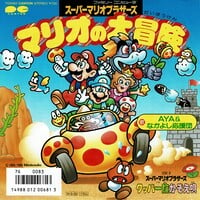Mario no Daibōken: Difference between revisions
No edit summary |
No edit summary |
||
| (4 intermediate revisions by 3 users not shown) | |||
| Line 2: | Line 2: | ||
[[File:Mario no Daibouken single cover.jpg|thumb|right|Single cover]] | [[File:Mario no Daibouken single cover.jpg|thumb|right|Single cover]] | ||
'''''Mario no Daibōken''''' (Japanese: マリオの大冒険, lit: ''Mario's Great Adventure'') is an obscure VHS and Betamax strategy guide released in Japan in 1986 by {{wp|Pony Canyon}} for | '''''Mario no Daibōken''''' (Japanese: マリオの大冒険, lit: ''Mario's Great Adventure'') is an obscure VHS and Betamax strategy guide released in Japan in 1986 by {{wp|Pony Canyon}} for ''[[Super Mario Bros.]]'' It features tips for various [[level]]s, live-action segments starring a [[Mario]] mascot costume, and ''[[Ground Theme (Super Mario Bros.)#Mario no Daibōken|Go Go Mario!!]]'', a lyrical version of the game's Ground Theme. ''Go Go Mario!!'' would later be released as a single in Japan. | ||
The video guides the viewer through a quick playthrough of ''Super Mario Bros.'', starting in [[World 1-1 (Super Mario Bros.)|World 1-1]], using the [[Warp Zone]] in [[World 1-2 (Super Mario Bros.)|World 1-2]] to warp to World 4, and using [[World 4-2 (Super Mario Bros.)|World 4-2]]'s Warp Zone to warp to World 8 and complete the game. | The video guides the viewer through a quick playthrough of ''Super Mario Bros.'', starting in [[World 1-1 (Super Mario Bros.)|World 1-1]], using the [[Warp Zone]] in [[World 1-2 (Super Mario Bros.)|World 1-2]] to warp to World 4, and using [[World 4-2 (Super Mario Bros.)|World 4-2]]'s Warp Zone to warp to World 8 and complete the game. | ||
The video also shows a variety of secrets such as the aforementioned Warp Zones in World 1-2 and | The video also shows a variety of secrets, such as the aforementioned Warp Zones in World 1-2 and World 4-2, various hidden 1-Up locations, and the infinite 1-Up trick in [[World 3-1 (Super Mario Bros.)|World 3-1]]. The video contains a rare instance of [[Nintendo]] officially showcasing and endorsing the use of [[glitch]]es in its games, featuring a segment all about various bugs present in the game. | ||
[[File:MarioDaibokenMascot.jpg|thumb|left|The Mario mascot costume]] All of this is regularly interrupted by live-action segments featuring a Mario mascot costume who can be seen playing the game. Mario introduces new segments and gives commentary, and plays a prominent role in the ''Go Go Mario!!'' music video shown at the end of the VHS. | [[File:MarioDaibokenMascot.jpg|thumb|left|The Mario mascot costume]] | ||
All of this is regularly interrupted by live-action segments featuring a Mario mascot costume who can be seen playing the game. Mario introduces new segments and gives commentary, and he plays a prominent role in the ''Go Go Mario!!'' music video shown at the end of the VHS. | |||
== Trivia == | ==Trivia== | ||
*The video's cover art would later be repurposed and modified to serve as the box art for ''[[All Night Nippon: Super Mario Bros.]]''<ref>{{media link|All Night Nippon Super Mario Bros cover.jpg|Box art of ''All Night Nippon: Super Mario Bros.''}}</ref> | *The [https://twitter.com/kikaim/status/1294964623657992193/photo/1 video's cover art] would later be repurposed and modified to serve as the box art for ''[[All Night Nippon: Super Mario Bros.]]''<ref>{{media link|All Night Nippon Super Mario Bros cover.jpg|Box art of ''All Night Nippon: Super Mario Bros.''}}</ref> | ||
== External links == | ==External links== | ||
*[https://youtu.be/wNfnvSMqZMw?si=8V5EGTrBF8klJuZM The full video] | *[https://youtu.be/wNfnvSMqZMw?si=8V5EGTrBF8klJuZM The full video] | ||
{{br}} | |||
== References == | ==References== | ||
<references/> | <references/> | ||
{{TV series and films}} | {{TV series and films}} | ||
[[Category: | [[Category:VHSes]] | ||
Latest revision as of 20:29, April 3, 2024
Mario no Daibōken (Japanese: マリオの大冒険, lit: Mario's Great Adventure) is an obscure VHS and Betamax strategy guide released in Japan in 1986 by Pony Canyon for Super Mario Bros. It features tips for various levels, live-action segments starring a Mario mascot costume, and Go Go Mario!!, a lyrical version of the game's Ground Theme. Go Go Mario!! would later be released as a single in Japan.
The video guides the viewer through a quick playthrough of Super Mario Bros., starting in World 1-1, using the Warp Zone in World 1-2 to warp to World 4, and using World 4-2's Warp Zone to warp to World 8 and complete the game.
The video also shows a variety of secrets, such as the aforementioned Warp Zones in World 1-2 and World 4-2, various hidden 1-Up locations, and the infinite 1-Up trick in World 3-1. The video contains a rare instance of Nintendo officially showcasing and endorsing the use of glitches in its games, featuring a segment all about various bugs present in the game.
All of this is regularly interrupted by live-action segments featuring a Mario mascot costume who can be seen playing the game. Mario introduces new segments and gives commentary, and he plays a prominent role in the Go Go Mario!! music video shown at the end of the VHS.
Trivia[edit]
- The video's cover art would later be repurposed and modified to serve as the box art for All Night Nippon: Super Mario Bros.[1]

